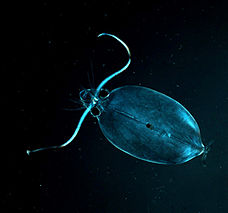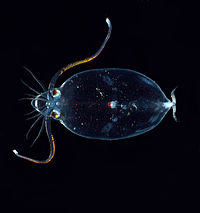- Glass squid
-
Glass squid 
Cranchiid squid juvenile found in plankton, Antarctica Scientific classification Kingdom: Animalia Phylum: Mollusca Class: Cephalopoda Subclass: Coleoidea Order: Teuthida Suborder: Oegopsina Family: Cranchiidae
Prosch, 1847Genera About 15, see text.
The family Cranchiidae comprises the approximately 60 species of glass squid, also known as cranchiid or cranch squid. Cranchiid squid occur in surface and midwater depths of open oceans around the world. They range in mantle length from 10 centimetres (3.9 in) to over 3 metres (9.8 ft), in the case of the Colossal Squid. The common name, glass squid, derives from the transparent nature of most species. Cranchiid squid spend much of their lives in partially sunlit shallow waters where their transparency provides camouflage. They are characterised by a swollen body and short arms, which bear two rows of suckers or hooks. The third arm pair is often enlarged. Many species are bioluminescent organisms and possess light organs on the undersides of their eyes, used to cancel their shadow. Eye morphology varies widely, ranging from large and circular to telescopic and stalked. A large fluid-filled chamber containing ammonia solution is used to aid buoyancy. Often the only organ that is visible through the transparent tissues is a cigar-shaped digestive gland, which is the cephalopod equivalent of a mammalian liver. This is usually held in a vertical position to reduce its silhouette and a light organ is sometimes present on the lower tip to further minimise its appearance in the water.
Like most squid, the juveniles of cranchiid squid live in surface waters, descending to deeper waters as they mature. Some species live over two kilometres below sea level. The body shape of many species changes drastically between growth stages and many young examples could be confused for different species altogether.
Cranchiid squid represent no interest to commercial fisheries.
A cranchiid squid observed during the Operation Deep Scope Expedition of 2004. The image on the right was taken with a polarising filter.Genera
- Subfamily Cranchiinae
- Genus Cranchia
- Genus Drechselia *
- Genus Leachia
- Genus Liocranchia
- Subfamily Taoniinae
- Genus Bathothauma
- Genus Belonella
- Genus Egea
- Genus Galiteuthis
- Genus Helicocranchia
- Genus Liguriella
- Genus Megalocranchia
- Genus Mesonychoteuthis
- Genus Sandalops
- Genus Taonius
- Genus Teuthowenia
The genus listed above with an asterisk (*) is questionable and needs further study to determine if it is a valid genus or a synonym.
References
- Norman, M. 2000. Cephalopods: A World Guide. Hackenheim, ConchBooks, p. 156.
- Tree of Life web project: Cranchiidae
External links

This squid-related article is a stub. You can help Wikipedia by expanding it. - Subfamily Cranchiinae


